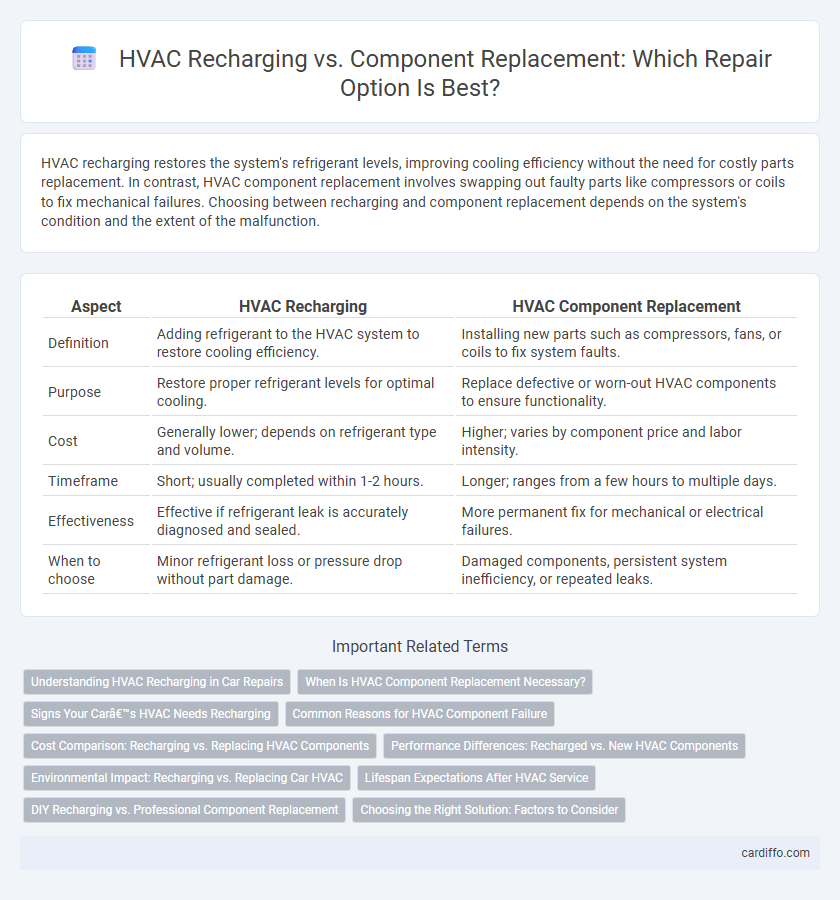HVAC recharging restores the system's refrigerant levels, improving cooling efficiency without the need for costly parts replacement. In contrast, HVAC component replacement involves swapping out faulty parts like compressors or coils to fix mechanical failures. Choosing between recharging and component replacement depends on the system's condition and the extent of the malfunction.
Table of Comparison
| Aspect | HVAC Recharging | HVAC Component Replacement |
|---|---|---|
| Definition | Adding refrigerant to the HVAC system to restore cooling efficiency. | Installing new parts such as compressors, fans, or coils to fix system faults. |
| Purpose | Restore proper refrigerant levels for optimal cooling. | Replace defective or worn-out HVAC components to ensure functionality. |
| Cost | Generally lower; depends on refrigerant type and volume. | Higher; varies by component price and labor intensity. |
| Timeframe | Short; usually completed within 1-2 hours. | Longer; ranges from a few hours to multiple days. |
| Effectiveness | Effective if refrigerant leak is accurately diagnosed and sealed. | More permanent fix for mechanical or electrical failures. |
| When to choose | Minor refrigerant loss or pressure drop without part damage. | Damaged components, persistent system inefficiency, or repeated leaks. |
Understanding HVAC Recharging in Car Repairs
HVAC recharging in car repairs involves replenishing the refrigerant levels to restore the system's cooling efficiency without replacing major components. Understanding the correct refrigerant type and proper charging techniques ensures optimal HVAC performance and prevents potential system damage. Regular diagnostics can determine if recharging is sufficient or if component replacement is necessary for long-term repair.
When Is HVAC Component Replacement Necessary?
HVAC component replacement becomes necessary when system efficiency drops despite regular recharging, indicating underlying mechanical or electrical failures. Signs such as frequent system breakdowns, unusual noises, or persistent temperature inconsistencies highlight issues like compressor failure, capacitor burnout, or refrigerant leaks. Recharging temporarily restores refrigerant levels but cannot fix damaged components critical to optimal HVAC operation.
Signs Your Car’s HVAC Needs Recharging
Signs your car's HVAC system needs recharging include weak airflow, inconsistent cabin temperature, and a noticeable lack of cold air from the vents. A decline in cooling performance often indicates low refrigerant levels, which can cause the compressor to overwork and potentially fail. Addressing these symptoms promptly with HVAC recharging can prevent costly component replacement such as compressor or condenser failures.
Common Reasons for HVAC Component Failure
Common reasons for HVAC component failure include electrical issues, such as capacitor and motor breakdowns, and mechanical wear affecting compressors and fans. Refrigerant leaks leading to low pressure and overheating often necessitate system recharging, but persistent leaks or compressor damage require component replacement. Neglecting routine maintenance accelerates corrosion, clogs filters, and strains parts, increasing the likelihood of expensive repairs or full HVAC system replacements.
Cost Comparison: Recharging vs. Replacing HVAC Components
HVAC recharging typically costs between $100 and $300, making it a more affordable short-term solution compared to component replacement, which can range from $500 to $2,500 depending on the part, such as compressors or coils. Recharging restores refrigerant levels but does not address underlying mechanical issues that may lead to frequent recharges and higher cumulative expenses. Replacing HVAC components involves higher upfront costs but offers long-term reliability and efficiency improvements, reducing overall maintenance and energy expenses.
Performance Differences: Recharged vs. New HVAC Components
HVAC recharging restores refrigerant levels, temporarily improving cooling performance but may not fully resolve system inefficiencies caused by worn components. New HVAC components provide optimal performance by eliminating leaks, ensuring proper airflow, and enhancing energy efficiency compared to recharged systems relying on aging parts. Consistent replacement of key elements like compressors, coils, and expansion valves results in longer system lifespan and more reliable temperature control than periodic refrigerant recharging alone.
Environmental Impact: Recharging vs. Replacing Car HVAC
Recharging a car HVAC system typically involves adding refrigerant to restore cooling efficiency, which can release greenhouse gases if not handled properly. Replacing HVAC components, such as compressors or condensers, often requires manufacturing new parts and disposing of old ones, increasing resource consumption and waste. Choosing recharging over component replacement generally has a lower environmental impact due to reduced material use and fewer emissions, provided refrigerant handling follows eco-friendly protocols.
Lifespan Expectations After HVAC Service
HVAC recharging typically extends the system's lifespan by several months to a year, primarily restoring refrigerant levels and improving cooling efficiency without addressing underlying component wear. In contrast, HVAC component replacement, such as swapping out compressors or condensers, offers a more significant lifespan boost, often adding 5 to 10 years depending on the quality of parts and installation. Regular maintenance combined with timely component replacement ensures optimal system performance and long-term durability.
DIY Recharging vs. Professional Component Replacement
HVAC recharging involves refilling the refrigerant to restore system cooling efficiency, which DIY enthusiasts can perform using proper tools and safety precautions. However, professional component replacement requires technical expertise to diagnose and replace faulty parts like compressors or capacitors, ensuring system longevity and compliance with environmental regulations. Choosing professional services for component replacement reduces risks of improper installation and refrigerant handling, avoiding costly damages and efficiency losses.
Choosing the Right Solution: Factors to Consider
Selecting between HVAC recharging and component replacement depends on the system's age, efficiency, and refrigerant leak severity. Recharging is cost-effective for minor refrigerant loss when components remain intact, while replacement is necessary for damaged compressors, faulty coils, or extensive system wear. Evaluating diagnostic pressure readings, refrigerant type compatibility, and labor costs ensures an informed decision for optimal HVAC performance and longevity.
HVAC recharging vs HVAC component replacement Infographic

 cardiffo.com
cardiffo.com